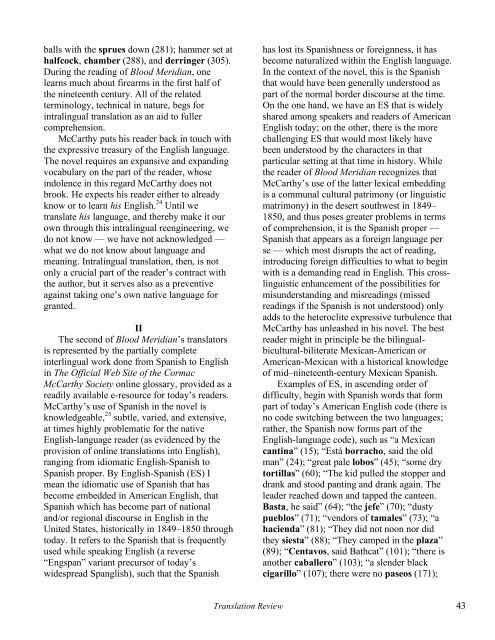Translation Review - The University of Texas at Dallas
Translation Review - The University of Texas at Dallas
Translation Review - The University of Texas at Dallas
You also want an ePaper? Increase the reach of your titles
YUMPU automatically turns print PDFs into web optimized ePapers that Google loves.
alls with the sprues down (281); hammer set <strong>at</strong><br />
halfcock, chamber (288), and derringer (305).<br />
During the reading <strong>of</strong> Blood Meridian, one<br />
learns much about firearms in the first half <strong>of</strong><br />
the nineteenth century. All <strong>of</strong> the rel<strong>at</strong>ed<br />
terminology, technical in n<strong>at</strong>ure, begs for<br />
intralingual transl<strong>at</strong>ion as an aid to fuller<br />
comprehension.<br />
McCarthy puts his reader back in touch with<br />
the expressive treasury <strong>of</strong> the English language.<br />
<strong>The</strong> novel requires an expansive and expanding<br />
vocabulary on the part <strong>of</strong> the reader, whose<br />
indolence in this regard McCarthy does not<br />
brook. He expects his reader either to already<br />
know or to learn his English. 24 Until we<br />
transl<strong>at</strong>e his language, and thereby make it our<br />
own through this intralingual reengineering, we<br />
do not know — we have not acknowledged —<br />
wh<strong>at</strong> we do not know about language and<br />
meaning. Intralingual transl<strong>at</strong>ion, then, is not<br />
only a crucial part <strong>of</strong> the reader’s contract with<br />
the author, but it serves also as a preventive<br />
against taking one’s own n<strong>at</strong>ive language for<br />
granted.<br />
II<br />
<strong>The</strong> second <strong>of</strong> Blood Meridian’s transl<strong>at</strong>ors<br />
is represented by the partially complete<br />
interlingual work done from Spanish to English<br />
in <strong>The</strong> Official Web Site <strong>of</strong> the Cormac<br />
McCarthy Society online glossary, provided as a<br />
readily available e-resource for today’s readers.<br />
McCarthy’s use <strong>of</strong> Spanish in the novel is<br />
knowledgeable, 25 subtle, varied, and extensive,<br />
<strong>at</strong> times highly problem<strong>at</strong>ic for the n<strong>at</strong>ive<br />
English-language reader (as evidenced by the<br />
provision <strong>of</strong> online transl<strong>at</strong>ions into English),<br />
ranging from idiom<strong>at</strong>ic English-Spanish to<br />
Spanish proper. By English-Spanish (ES) I<br />
mean the idiom<strong>at</strong>ic use <strong>of</strong> Spanish th<strong>at</strong> has<br />
become embedded in American English, th<strong>at</strong><br />
Spanish which has become part <strong>of</strong> n<strong>at</strong>ional<br />
and/or regional discourse in English in the<br />
United St<strong>at</strong>es, historically in 1849–1850 through<br />
today. It refers to the Spanish th<strong>at</strong> is frequently<br />
used while speaking English (a reverse<br />
“Engspan” variant precursor <strong>of</strong> today’s<br />
widespread Spanglish), such th<strong>at</strong> the Spanish<br />
has lost its Spanishness or foreignness, it has<br />
become n<strong>at</strong>uralized within the English language.<br />
In the context <strong>of</strong> the novel, this is the Spanish<br />
th<strong>at</strong> would have been generally understood as<br />
part <strong>of</strong> the normal border discourse <strong>at</strong> the time.<br />
On the one hand, we have an ES th<strong>at</strong> is widely<br />
shared among speakers and readers <strong>of</strong> American<br />
English today; on the other, there is the more<br />
challenging ES th<strong>at</strong> would most likely have<br />
been understood by the characters in th<strong>at</strong><br />
particular setting <strong>at</strong> th<strong>at</strong> time in history. While<br />
the reader <strong>of</strong> Blood Meridian recognizes th<strong>at</strong><br />
McCarthy’s use <strong>of</strong> the l<strong>at</strong>ter lexical embedding<br />
is a communal cultural p<strong>at</strong>rimony (or linguistic<br />
m<strong>at</strong>rimony) in the desert southwest in 1849–<br />
1850, and thus poses gre<strong>at</strong>er problems in terms<br />
<strong>of</strong> comprehension, it is the Spanish proper —<br />
Spanish th<strong>at</strong> appears as a foreign language per<br />
se — which most disrupts the act <strong>of</strong> reading,<br />
introducing foreign difficulties to wh<strong>at</strong> to begin<br />
with is a demanding read in English. This crosslinguistic<br />
enhancement <strong>of</strong> the possibilities for<br />
misunderstanding and misreadings (missed<br />
readings if the Spanish is not understood) only<br />
adds to the heteroclite expressive turbulence th<strong>at</strong><br />
McCarthy has unleashed in his novel. <strong>The</strong> best<br />
reader might in principle be the bilingualbicultural-biliter<strong>at</strong>e<br />
Mexican-American or<br />
American-Mexican with a historical knowledge<br />
<strong>of</strong> mid–nineteenth-century Mexican Spanish.<br />
Examples <strong>of</strong> ES, in ascending order <strong>of</strong><br />
difficulty, begin with Spanish words th<strong>at</strong> form<br />
part <strong>of</strong> today’s American English code (there is<br />
no code switching between the two languages;<br />
r<strong>at</strong>her, the Spanish now forms part <strong>of</strong> the<br />
English-language code), such as “a Mexican<br />
cantina” (15); “Está borracho, said the old<br />
man” (24); “gre<strong>at</strong> pale lobos” (45); “some dry<br />
tortillas” (60); “<strong>The</strong> kid pulled the stopper and<br />
drank and stood panting and drank again. <strong>The</strong><br />
leader reached down and tapped the canteen.<br />
Basta, he said” (64); “the jefe” (70); “dusty<br />
pueblos” (71); “vendors <strong>of</strong> tamales” (73); “a<br />
hacienda” (81); “<strong>The</strong>y did not noon nor did<br />
they siesta” (88); “<strong>The</strong>y camped in the plaza”<br />
(89); “Centavos, said B<strong>at</strong>hc<strong>at</strong>” (101); “there is<br />
another caballero” (103); “a slender black<br />
cigarillo” (107); there were no paseos (171);<br />
<strong>Transl<strong>at</strong>ion</strong> <strong>Review</strong> 43

















